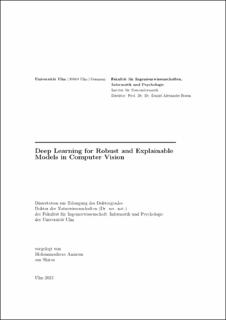Please use this identifier to cite or link to this item:
https://doi.org/10.21256/zhaw-29558| Publication type: | Doctoral thesis |
| Title: | Deep learning for robust and explainable models in computer vision |
| Authors: | Amirian, Mohammadreza |
| Advisors / Reviewers: | Schwenker, Friedhelm Stadelmann, Thilo Jaggi, Martin |
| DOI: | 10.18725/OPARU-51464 10.21256/zhaw-29558 |
| Extent: | XIV, 150 |
| Issue Date: | 2023 |
| Publisher / Ed. Institution: | Universität Ulm |
| Other identifiers: | urn:nbn:de:bsz:289-oparu-51540-1 |
| Language: | English |
| Subjects: | Machine learning; Robust control; Deep learning; Convolutional neural network (CNN); Vision transformer (ViT); Robustness; Explainability |
| Subject (DDC): | 006: Special computer methods |
| Abstract: | Recent breakthroughs in machine and deep learning (ML and DL) research have provided excellent tools for leveraging enormous amounts of data and optimizing huge models with millions of parameters to obtain accurate networks for image processing. These developments open up tremendous opportunities for using artificial intelligence (AI) in the automation and human assisted AI industry. However, as more and more models are deployed and used in practice, many challenges have emerged. This thesis presents various approaches that address robustness and explainability challenges for using ML and DL in practice. Robustness and reliability are the critical components of any model before certification and deployment in practice. Deep convolutional neural networks (CNNs) exhibit vulnerability to transformations of their inputs, such as rotation and scaling, or intentional manipulations as described in the adversarial attack literature. In addition, building trust in AI-based models requires a better understanding of current models and developing methods that are more explainable and interpretable a priori. This thesis presents developments in computer vision models' robustness and explainability. Furthermore, this thesis offers an example of using vision models' feature response visualization (models' interpretations) to improve robustness despite interpretability and robustness being seemingly unrelated in the related research. Besides methodological developments for robust and explainable vision models, a key message of this thesis is introducing model interpretation techniques as a tool for understanding vision models and improving their design and robustness. In addition to the theoretical developments, this thesis demonstrates several applications of ML and DL in different contexts, such as medical imaging and affective computing. |
| URI: | https://digitalcollection.zhaw.ch/handle/11475/29558 |
| License (according to publishing contract): | CC BY-NC-ND 4.0: Attribution - Non commercial - No derivatives 4.0 International |
| Departement: | School of Engineering |
| Organisational Unit: | Centre for Artificial Intelligence (CAI) |
| Appears in collections: | Publikationen School of Engineering |
Files in This Item:
| File | Description | Size | Format | |
|---|---|---|---|---|
| 2023_Amirian_Dissertation_small.pdf | 2.86 MB | Adobe PDF |  View/Open |
Show full item record
Amirian, M. (2023). Deep learning for robust and explainable models in computer vision [Doctoral dissertation, Universität Ulm]. https://doi.org/10.18725/OPARU-51464
Amirian, M. (2023) Deep learning for robust and explainable models in computer vision. Doctoral dissertation. Universität Ulm. Available at: https://doi.org/10.18725/OPARU-51464.
M. Amirian, “Deep learning for robust and explainable models in computer vision,” Doctoral dissertation, Universität Ulm, 2023. doi: 10.18725/OPARU-51464.
AMIRIAN, Mohammadreza, 2023. Deep learning for robust and explainable models in computer vision. Doctoral dissertation. Universität Ulm
Amirian, Mohammadreza. 2023. “Deep Learning for Robust and Explainable Models in Computer Vision.” Doctoral dissertation, Universität Ulm. https://doi.org/10.18725/OPARU-51464.
Amirian, Mohammadreza. Deep Learning for Robust and Explainable Models in Computer Vision. Universität Ulm, 2023, https://doi.org/10.18725/OPARU-51464.
Items in DSpace are protected by copyright, with all rights reserved, unless otherwise indicated.